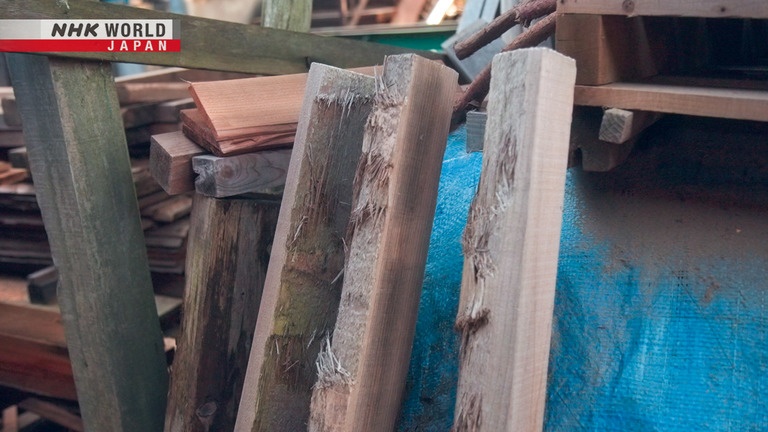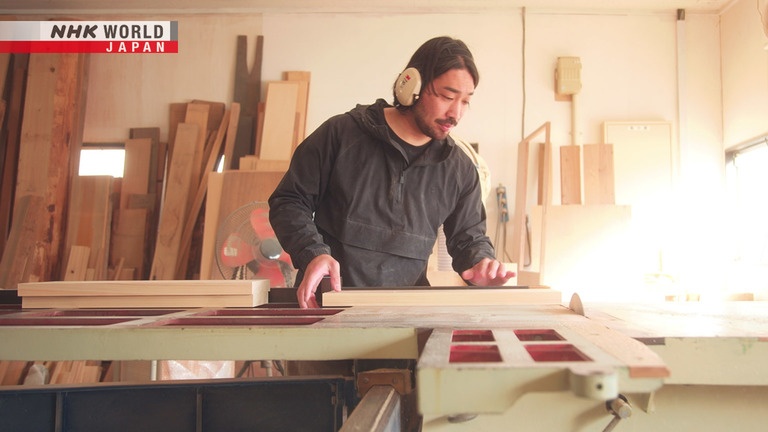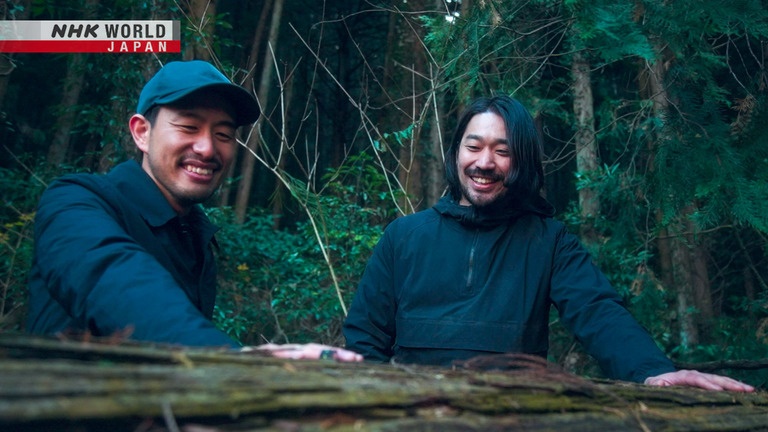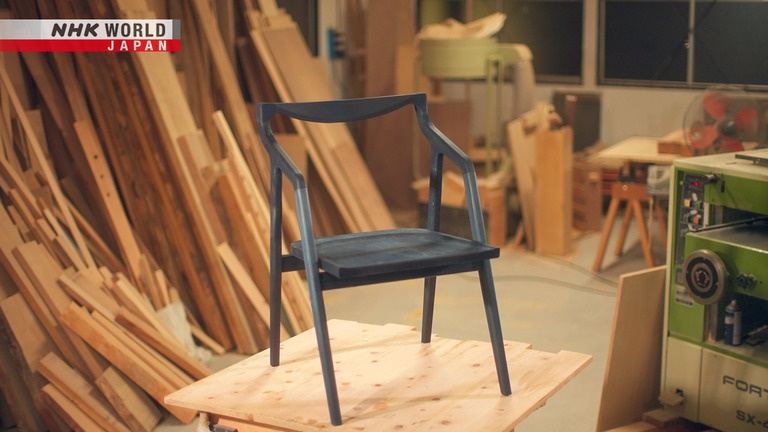Furniture in Blue
Lumber that's too short or too narrow can be hard to sell. Offcuts are usually discarded or end up as woodchips. But Tanaka Ryosuke and Miyachi Yoh use them for furniture. Not big enough for large panels, multiple boards must be glued together, leading to uneven coloring. The answer, to dye the furniture with indigo, transforming each piece into a unified whole. This clever idea and their love of wood itself gives their work an inner beauty that's attracting real interest.




Transcript
Since ancient times, the Japanese have believed that a life force resides in all creations.
Valuing and caring for the things we use, a "Zero Waste Life."
Pointing the way to better living for a new era.
A mountainous area 45km west of central Tokyo.
A lumber mill processing locally harvested trees.
This man is a regular visitor.
Woodworker Tanaka Ryosuke.
Japanese cedar. It might work.
He's looking for material for furniture, but perhaps not quite what you'd imagine.
This is all just scrap.
Yeah. This is more like it.
Offcuts from boards that were too long.
"What'll happen if he doesn't take it?"
It's too small for building material.
They might end up as firewood.
It's scrap, but for furniture
you can cut out a good 6 x 6cm.
The best-selling timber products are boards over 8m long suited for use in construction.
Tanaka takes the offcuts that are not long or wide enough, which would normally be thrown out or turned into woodchips.
This is Tanaka's workshop.
He'll use the lumber he collected to make a chair.
He starts with the seat.
The board isn't wide enough, so he cuts out three sections to make up a panel.
The usable section is really narrow,
so I'll really be cutting it close.
I think I'll be able to make it work.
He does his best to line up the woodgrain.
Overseeing his work is Miyachi Yo.
He's Tanaka's partner in the scrap wood furniture business, handling design and branding.
They discuss how to make the most of the wood's unique character.
The woodgrain here spreads out,
so it should look nice once it's carved.
A beautiful seat that looks as though it were shaped from single board.
The other cutoffs will form the rest of the chair.
Even for a flowing design like this,
if the legs aren't structurally straight, the weight won't be evenly distributed.
His technique and skill make it work.
So, there's a balance between
strength and design.
Made from multiple scraps, the completed chair still has areas of uneven color.
One vital step remains before the piece will meet their demanding expectations.
The partners met 12 years ago.
At the time, they were both studying architecture.
After graduation, Tanaka trained as a furniture maker.
Miyachi got a job in architecture, starting his own business doing renovation and space creation.
But he began to feel out of place in the construction business.
Building involves many hands.
Particularly considering current eco-trends,
it uses a lot of resources, with little discussion of whether
it was necessary to build at all.
How to make something new
using only what you have now?
I found that question interesting.
While visiting a logging site run by his brother who works as a forester, he saw timber that had been left unused for years because it was unprofitable to mill.
Miyachi test milled some of the lumber to confirm that it was usable.
The wood looked good at first glance.
But it had sat there for 20 years
and nobody ever found a use for it.
I wondered if it could become furniture
that someone would actually use.
Having made up his mind to proceed, it was Tanaka he approached to be his business partner.
Tanaka had just finished his training as a furniture maker.
Instead of going out of your way
to use imported rare wood, isn't it better to use the good
surplus wood right in front of you?
I think it's only natural for makers
in the current era to do it this way.
They decided to make a table.
With no large boards available, they glued up smaller ones into a large panel.
But the resulting tabletop was too non-uniform in appearance for their liking.
To make up for this, they decided to use a certain special technique.
Traditional indigo dyeing.
It's normally used for softer materials like cloth or paper, but after much trial and error the pair figured out how to make it work on furniture.
In the case of Japanese cypress,
it can be white, brown, even pink.
This makes it hard to unify
and pieces can look dirty.
Indigo dyeing is the solution.
A table made from unwanted wood formed the starting point for their endeavor.
The scrap wood chair too is now carefully stained with the indigo dye.
I think it came out nicely.
It's the best one yet.
Indigo dye accentuates the beauty of the woodgrain.
Despite being pieced together from scrap wood, there's no color variation, and the chair feels like a unified whole.
Furniture and crafts made with material that would have otherwise gone to waste and dyed with indigo.
The brand they created is attracting interest.
They've brought the dyed chair to the mill where they received the offcuts.
Wonderful.
- The seat's three boards, right?
- Yes. Have a seat if you like.
Really nice.
It's so comfortable.
The wood must feel happy
to become such an amazing chair.
They say trees live twice,
first in the mountains and then as lumber.
But to be reborn as such a chair
it can live forever.
- Thank you.
- We should be thanking you.
We do our best to express
the quality of the wood, to help it say something new,
and to give it new value.
Today they're visiting a logging site in the mountains.
Large-scale tree planting has long been promoted in Japan.
But imported wood and other materials mean reduced demand for domestic timber.
Trees are felled for forest beautification and as countermeasure to hay fever but are all too often left to rot where they fall.
This is Miyachi's brother who works as a forester.
It's a waste just leaving them here.
There ought to be a use for them.
- "What will happen to those trees?"
- They'll just rot here on the mountain.
Such timber can be found all over Japan, but even if you want to use it, getting it off the mountain can be costly.
The partners hope, in some small way, to be able to change the current situation.
Our furniture connects you with
the mountains, makes you more aware of where wood actually comes from,
the mountains and the trees.
That's what we intend it to do.
We can have an impact by making
good things, things to be used.
That's how we as creators can help
to beautify the mountains.